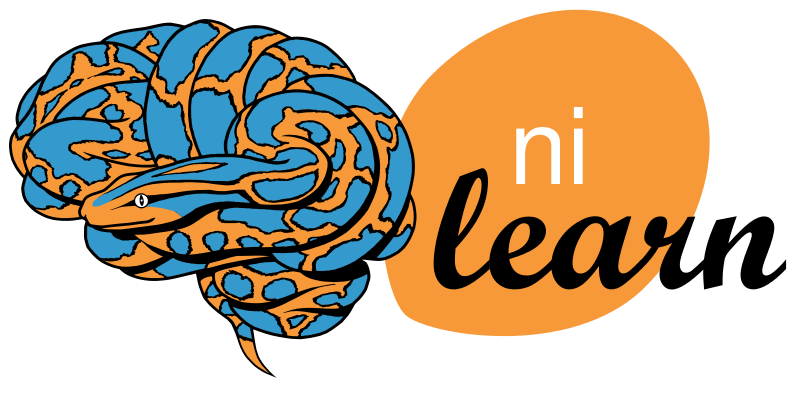Note
This page is a reference documentation. It only explains the class signature, and not how to use it. Please refer to the user guide for the big picture.
nilearn.decomposition.CanICA¶
-
class
nilearn.decomposition.CanICA(mask=None, n_components=20, smoothing_fwhm=6, do_cca=True, threshold='auto', n_init=10, standardize=True, random_state=0, target_affine=None, target_shape=None, low_pass=None, high_pass=None, t_r=None, memory=Memory(cachedir=None), memory_level=0, n_jobs=1, verbose=0)¶ Perform Canonical Independent Component Analysis.
Parameters: mask: Niimg-like object or MultiNiftiMasker instance, optional :
Mask to be used on data. If an instance of masker is passed, then its mask will be used. If no mask is given, it will be computed automatically by a MultiNiftiMasker with default parameters.
data: array-like, shape = [[n_samples, n_features], ...] :
Training vector, where n_samples is the number of samples, n_features is the number of features. There is one vector per subject.
n_components: int :
Number of components to extract
smoothing_fwhm: float, optional :
If smoothing_fwhm is not None, it gives the size in millimeters of the spatial smoothing to apply to the signal.
do_cca: boolean, optional :
Indicate if a Canonical Correlation Analysis must be run after the PCA.
standardize : boolean, optional
If standardize is True, the time-series are centered and normed: their variance is put to 1 in the time dimension.
threshold: None, ‘auto’ or float :
If None, no thresholding is applied. If ‘auto’, then we apply a thresholding that will keep the n_voxels, more intense voxels across all the maps, n_voxels being the number of voxels in a brain volume. A float value indicates the ratio of voxels to keep (2. means keeping 2 x n_voxels voxels).
n_init: int, optional :
The number of times the fastICA algorithm is restarted
random_state: int or RandomState :
Pseudo number generator state used for random sampling.
target_affine: 3x3 or 4x4 matrix, optional :
This parameter is passed to image.resample_img. Please see the related documentation for details.
target_shape: 3-tuple of integers, optional :
This parameter is passed to image.resample_img. Please see the related documentation for details.
low_pass: None or float, optional :
This parameter is passed to signal.clean. Please see the related documentation for details
high_pass: None or float, optional :
This parameter is passed to signal.clean. Please see the related documentation for details
t_r: float, optional :
This parameter is passed to signal.clean. Please see the related documentation for details
memory: instance of joblib.Memory or string :
Used to cache the masking process. By default, no caching is done. If a string is given, it is the path to the caching directory.
memory_level: integer, optional :
Rough estimator of the amount of memory used by caching. Higher value means more memory for caching.
n_jobs: integer, optional :
The number of CPUs to use to do the computation. -1 means ‘all CPUs’, -2 ‘all CPUs but one’, and so on.
verbose: integer, optional :
Indicate the level of verbosity. By default, nothing is printed
References
- G. Varoquaux et al. “A group model for stable multi-subject ICA on fMRI datasets”, NeuroImage Vol 51 (2010), p. 288-299
- G. Varoquaux et al. “ICA-based sparse features recovery from fMRI datasets”, IEEE ISBI 2010, p. 1177
Methods
-
__init__(mask=None, n_components=20, smoothing_fwhm=6, do_cca=True, threshold='auto', n_init=10, standardize=True, random_state=0, target_affine=None, target_shape=None, low_pass=None, high_pass=None, t_r=None, memory=Memory(cachedir=None), memory_level=0, n_jobs=1, verbose=0)¶
-
fit(imgs, y=None, confounds=None)¶ Compute the mask and the ICA maps across subjects
Parameters: imgs: list of Niimg-like objects :
See http://nilearn.github.io/building_blocks/manipulating_mr_images.html#niimg. Data on which PCA must be calculated. If this is a list, the affine is considered the same for all.
confounds: CSV file path or 2D matrix :
This parameter is passed to nilearn.signal.clean. Please see the related documentation for details
-
fit_transform(X, y=None, **fit_params)¶ Fit to data, then transform it.
Fits transformer to X and y with optional parameters fit_params and returns a transformed version of X.
Parameters: X : numpy array of shape [n_samples, n_features]
Training set.
y : numpy array of shape [n_samples]
Target values.
Returns: X_new : numpy array of shape [n_samples, n_features_new]
Transformed array.
-
get_params(deep=True)¶ Get parameters for this estimator.
Parameters: deep: boolean, optional :
If True, will return the parameters for this estimator and contained subobjects that are estimators.
Returns: params : mapping of string to any
Parameter names mapped to their values.
-
inverse_transform(component_signals)¶ Transform regions signals into voxel signals
Parameters: component_signals: list of numpy array (n_samples x n_components) :
Component signals to tranform back into voxel signals
-
set_params(**params)¶ Set the parameters of this estimator.
The method works on simple estimators as well as on nested objects (such as pipelines). The former have parameters of the form
<component>__<parameter>so that it’s possible to update each component of a nested object.Returns: self :
-
transform(imgs, confounds=None)¶ Project the data into a reduced representation
Parameters: imgs: iterable of Niimg-like objects :
See http://nilearn.github.io/building_blocks/manipulating_mr_images.html#niimg. Data to be projected
confounds: CSV file path or 2D matrix :
This parameter is passed to nilearn.signal.clean. Please see the related documentation for details
